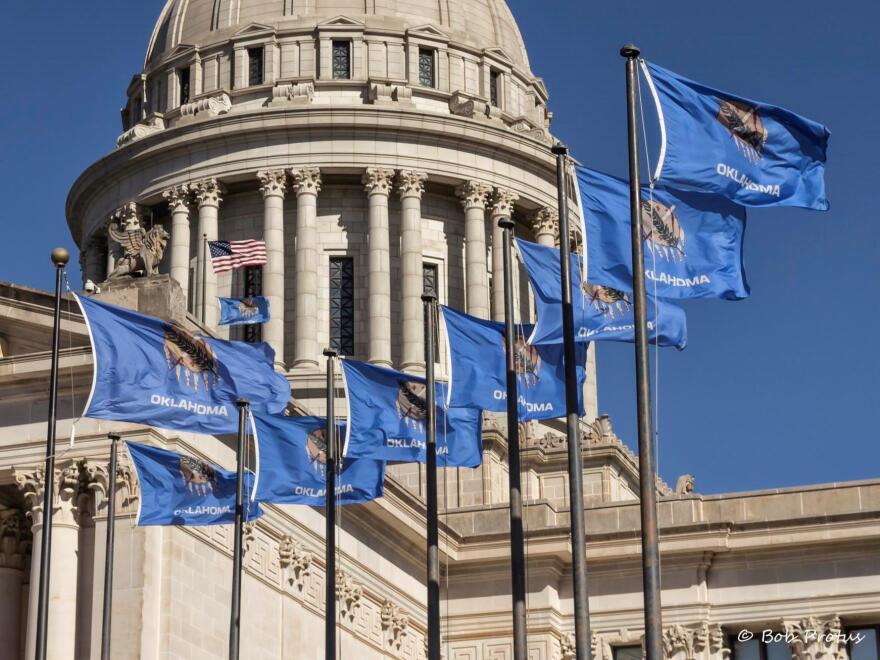Oklahoma Historical Society executive director Bob Blackburn says he doesn’t think the calls to remove the Confederate battle flag from state Capitols in South Carolina or Alabama – or the move by retailers like Wal-Mart, Amazon, and Sears to stop selling merchandise featuring the symbol – will impact one of the 14 flags flying at the Oklahoma History Center.
The reaction to the Civil War-era symbol comes after nine people were gunned down at an historically black church in South Carolina. The alleged shooter, 21-year-old Dylann Roof, reportedly embraced the flag and white supremacist causes, and made racially insensitive comments shortly before and during the shooting.
eCapitol's Shawn Ashley reports Oklahoma state law requires the First National Flag of the Confederacy – the so-called "Stars and Bars" and not the battle flag of the Army of Northern Virginia at the center of South Carolina's debate - to be flown at the History Center in Oklahoma City.
Blackburn said, "I have always been of the opinion that the Confederate (National Flag) should be included to be historically accurate." Blackburn said he thinks it is the historical accuracy of exhibits about the Civil War, slavery and related topics at the History Center is what has made them acceptable to the public and popular. And without discussing those time periods and the events in them, he added, "The rest of the story does not make sense. "How do you talk about the black townships in Oklahoma if you don't talk about the Freedmen?" Blackburn explained. "And to talk about the Freedmen, you have to talk about slavery, the Civil War and the Confederacy." He added, "If you take out the middle section, a historian can't make sense of what happened."
Despite the fact that the Civil War ended 42 years before statehood, Oklahoma has several interesting links with the Confederacy.
Blackburn said two representatives from Oklahoma attended the 1861 Confederate Congress, and later that year five Oklahoma Native American tribes signed treaties of alliance with the Confederate government.
On June 23, 1865, Cherokee Nation Principal Chief Stand Watie, who was also a Brigadier General in the Confederate Army, became the last field general to surrender to Union forces. His First Indian Brigade of the Army of the Trans-Mississippi laid down its arms at Doaksville in the Choctaw Nation, near the present-day town of Fort Towson in southeast Oklahoma.
South Carolina added the Confederate battle flag to the dome of the state Capitol in 1962 in response to desegregation and the Civil Rights Movement. Oklahoma added the “Stars and Bars” flag to the Capitol grounds in 1966 to commemorate the 14 flags that have flown over territory that makes up modern-day Oklahoma. A nearly identical set-up was part of Oklahoma's contribution to the 1964 World's Fair.
Several versions of the U.S. and Oklahoma flags fly in the display, along with the colors of Great Britain, France, Spain, Texas and the Choctaw Nation. Texas’ similar commemoration of its own six territorial flags inspired the name of the popular Six Flags theme park chain.
The state unveiled semicircle of 14 flags on the Capitol’s south end in 1966 during the first term of Gov. Henry Bellmon, according to The Oklahoman's Adam Kemp.
In March 1988, workers removed the flags during a renovation of the Capitol grounds. The poles remained empty for more than a year. When the flags returned, the Confederate flag was absent, its pole remaining bare among the other 13. Earlier that year, Rep. Don Ross, D-Tulsa, had objected to the flag and asked that it be taken down, but it’s unclear whether that request led to the flag’s removal. “The lowering and removal of this objectionable reminder of those dark days will symbolize also the lowering of those barriers allowing a person to be judged not by color, but by the content of their character,” Ross said. “That has become a symbol of the (Ku Klux) Klan and every other right-wing group. If that offends one of us, it ought to offend all of us.” Bellmon left the decision of whether the flag should fly again to the state Legislature. He asked them which of seven different Confederate flags they wanted flown. A decision never came, and the pole remained empty for several years.
Gov. Frank Keating decided put 14 Oklahoma state flags on the poles in 2002, a tradition continued by Gov. Brad Henry in 2003 and Gov. Mary Fallin in 2011.

KGOU is a community-supported news organization and relies on contributions from readers and listeners to fulfill its mission of public service to Oklahoma and beyond. Donate online, or by contacting our Membership department.








